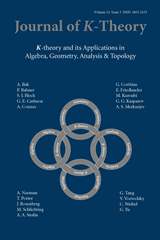Article contents
The Guillemin–Sternberg conjecture for noncompact groups and spaces
Published online by Cambridge University Press: 11 February 2008
Abstract
The Guillemin–Sternberg conjecture states that “quantisation commutes with reduction” in a specific technical setting. So far, this conjecture has almost exclusively been stated and proved for compact Lie groups G acting on compact symplectic manifolds, and, largely due to the use of Spinc Dirac operator techniques, has reached a high degree of perfection under these compactness assumptions. In this paper we formulate an appropriate Guillemin–Sternberg conjecture in the general case, under the main assumptions that the Lie group action is proper and cocompact. This formulation is motivated by our interpretation of the “quantisation commuates with reduction” phenomenon as a special case of the functoriality of quantisation, and uses equivariant K-homology and the K-theory of the group C*-algebra C*(G) in a crucial way. For example, the equivariant index – which in the compact case takes values in the representation ring R(G) – is replaced by the analytic assembly map – which takes values in K0(C*(G)) – familiar from the Baum–Connes conjecture in noncommutative geometry. Under the usual freeness assumption on the action, we prove our conjecture for all Lie groups G having a discrete normal subgroup Γ with compact quotient G/Γ, but we believe it is valid for all unimodular Lie groups.
- Type
- Research Article
- Information
- Copyright
- Copyright © ISOPP 2008
References
- 14
- Cited by




